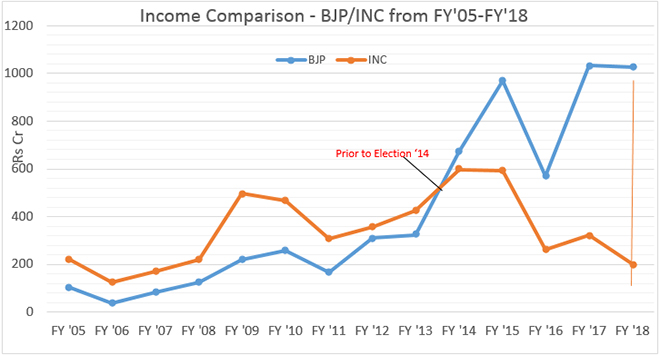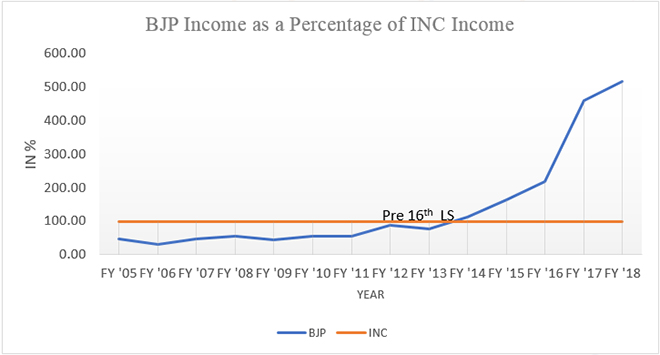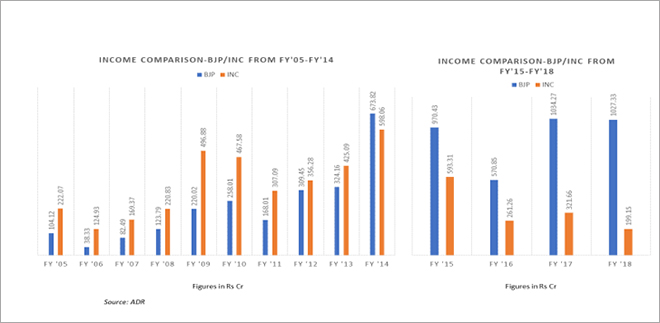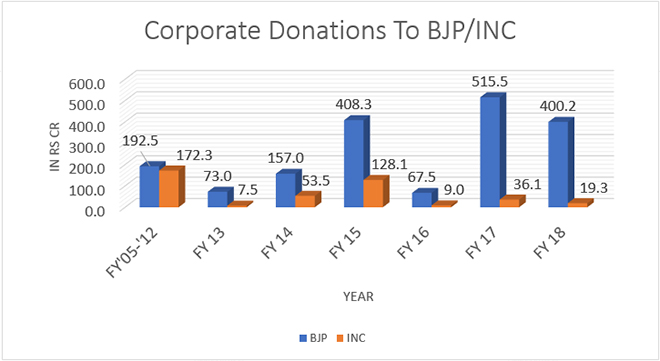It was widely reported last year that the Indian National Congress (INC), the main political opposition and a contender for power in the 2019 polls, has ran out of money. Divya Spandana, who leads the party’s social media wing, openly confessed that the INC has no money to run its mundane political activities. It appears that the oldest national party does not have the funds to run its offices in several states and senior functionaries were asked to cut down their travel expenses.
While this may come as a shock to fans of the party which was in power not very long ago, key statistics of its finance clearly indicate the party is in a tight spot as far as donation aggregation goes. While the Congress raised Rs 225 crore for the year in question, it spent about Rs 321 crore – more than Rs 96 crore from the earned donations. This prompted party president Rahul Gandhi to make an urgent appeal for donations last year.
While 2018 was an extraordinarily tight year for the Congress party considering that the party fought a spate of state assembly elections including the electorally significant Rajasthan, Chhattisgarh and Madhya Pradesh requiring considerable expenditures, the fact is the party’s coffers have been experiencing a sharp decline in funds ever since it lost power in 2014. The declared income of the party for FY 2017-18 was its lowest in 11 years, and 12 per cent lower than the previous financial year.
Figure 1: Comparative flow of BJP and Congress Income

Figure 2: BJP income as percentage of the INC Income

Figure 3: Cumulative donation to the BJP and the INC (2005-18)

Ever-widening funding gap
Where does the Congress party stand when compared to the ruling Bharatiya Janata Party (BJP)? While the Congress party is ahead of other national parties in terms of total donations (raised by various means such as membership fees, sale of coupons, individual denotations, electoral trusts, electoral bonds, rents from properties, etc), the oldest party earned less than one-fifth of what the ruling party received in 2017-18. As per the income tax returns and annual audit reports of both national parties, the Congress party raised about Rs 199 crore in donations for the year, compared to an impressive Rs 1,027 crore by the ruling party. To put it differently, in the combined income of the two biggest national parties, the Congress’s share was a meagre 16 per cent (Figure 2).
In terms of donations above Rs 20,000, the BJP raked up Rs 437 crore in FY 2017-18 compared to Rs 26 crore by the Congress party for the same year. Overall, the ruling party earned 13 times more than the combined similar donations received by other national parties, including the Congress party.
Not a very long ago, the Congress was at the pole position in political donations. For instance, in 2012, it raised about Rs 356 crore against Rs 309 crore by the then main opposition party, BJP. If one goes back a little further, the ruling Congress in 2006 raked up as much as 3.25 time more donations than the BJP. However, the Congress party’s fortune started to slide after it faced a flood of allegations of corruption and big ticket scandals around 2012-13, which coincided with the rising stock of the once dormant BJP. Even before it assumed power in 2014, the opposition BJP surpassed the ruling Congress in political donations. For instance, while the Congress raised Rs 598 crore for the FY 2013-14, the BJP collected as much as Rs 673 crore for the same year (Figure 3).
Figure 4: Comparative statistics of corporate donation to the BJP and the Congress

Blame corporate donors for the growing divide
The BJP’s phenomenal rise in capturing more than 80 per cent of the total donations and the Congress’s sharp deceleration are closely linked to how they tapped the corporate donations. For example, the BJP in FY 2017-18 tapped a staggering 92 per cent of the total corporate donations (Figure 4). This disparity is even starker when compared with the Congress: while the BJP received as much as Rs 400 crore of the corporate donations, the Congress party received as little as Rs 19 crore in FY 2017-18 (Figure 4). To put it another way, the BJP tapped 21 times more of corporate donations than the Congress could in FY 2017-18.
Of course, the BJP for long has been occupying a pole position in tapping corporate donations. Even when the Congress party was in power, the BJP collected more money from businesses and corporates. While the ruling Congress party could raise about Rs 172 crore in the years 2005-12, the BJP tapped Rs 192 crore in the same period (Figure 4). Still, the gap in corporate donations then was modest, compared to what it is now. Since 2013, the business/corporate donors have contributed a whooping Rs 1,621 crore to the BJP, while the Congress received only Rs 235 crore.
Electoral Trusts fuelling funding disparities
What is contributing to this growing gap in corporate donations between the two major national parties? While the usual explanations that the BJP has a close proximity to small businesses and trading communities and also are aggressive in tapping donations still hold good, a key contributor to such growing disparities in corporate funding are the electoral trusts. In its less than a decade long existence, electoral trusts have emerged as the biggest channel for corporate donations in India. Since 2013, more than two-thirds of corporate donations are being routed through this route. Some of the richest electoral trusts have been donating generously to the BJP, rather than to other national parties, including the Congress party. Of the 22 registered electoral trusts and their donations for FY 2017-18, the BJP received 85 per cent of the total contributions. For example, the richest Prudent Electoral Trust contributed a staggering Rs 144 crore (around 85 per cent) to the BJP alone. The Congress party received only a paltry Rs 10 crore from the same trust for the said period. Further, since its formation in 2014, the Prudent Electoral Trust has donated Rs 594.37 crore (82 per cent) to the BJP, out of its total Rs 726.13 contributions.
The story does not end with the electoral trusts alone. Now with the electoral bonds (where more than 99.9 per cent donations are of high value indicating their business links) also in the game, the gap in corporate donations is growing wider. In 2018, the ruling party collected as much as 95 per cent of the donations routed through the electoral bonds. The audit and income tax reports of the BJP suggest that the ruling party received Rs 210 crore of the total Rs 222 crore donated through the electoral bonds in March 2018. The Congress received a meagre Rs 5 crore for the same period.
Too much gap not good for democracy
Of course, one cannot blame the ruling BJP for collecting more money than the other national parties. With close proximity to business and trading communities, it always finds its easy to raise more funds than the Congress. Yet, the gap was never so wide as it is now. While the BJP’s spectacular victory in the 2014 general elections and its phenomenal spread over many states allow it to win over the corporates and big donors, the Congress’s drastic slide in the donation basket has no easy answers.
Has the opposition Congress lost the confidence of business community or has this something to do with the party’s uncertain political prospects? Whatever be the reason, such a large gap in political donations between the ruling party and the principal opposition does not augur well for the health of the democracy. While income or donations is by no means a clear indicator of winning in elections, campaign finance literature does offer enough insights into how political parties with well-oiled campaign machines often have a disproportionate advantage over their cash-starved rivals in mounting effective campaign communication and narrative buildings. This is clearly visible in the 2019 general elections.
Niranjan Sahoo is a Senior Fellow and Niraj Tiwari a Research Intern at Observer Research Foundation, Delhi. Views are personal.
The article was first published on ORF.




Blue for BJP and Saffron for Congress. All hail the brilliant print staff.
I doubt the figures quoted in this Article, simply because no party actually is clean when it comes to reporting. But still, the gap between BJP & Cong seems to be very wide. That’s probably natural, no one wants to bet on a losing horse.
The writer has given only factual details of the funding pattern but failed to detail the reason for the same…. One reason may be Khongress’s antipathy to the business class by continuous Ambani- Adani Sarkar jibe…. The country can not prosper without prospering of the industries…. And Khongress’ continuous slanderous campaign against the industry leaders by name, may have gone against the grand old party….. The present leadership of the Khongress don’t have experience in Govt administration and those have experience in the party can not boast their knowledge….
BJP is the only political party that is fighting to make a government on their own. What do you expect. Why will anyone contribute to a party which is not going even 100 seats ?
By the way, the article is very informative. Keep up the good work.
Dear Authors
Can you explain how you calculate the share of corporate donors? If I am not mistaken ADR does not identify the donor type.
Thanks
Rohit